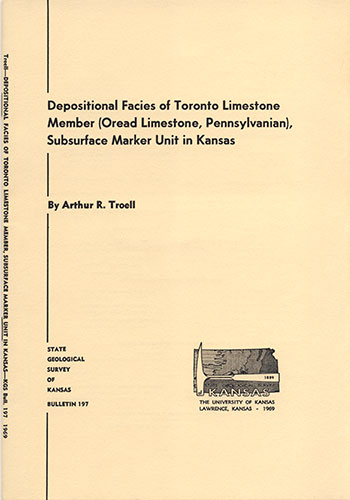Depositional Facies of Toronto Limestone Member (Oread Limestone, Pennsylvanian), Subsurface Marker Unit in Kansas
DOI:
https://doi.org/10.17161/kgsbulletin.no.i197.22222Abstract
The Toronto limestone Member, at the base of the Oread Limestone (Pennsylvanian), averages about 10 feet in thickness. It is exposed in southeastern Nebraska and northwestern Missouri and can be traced across eastern Kansas, grading southward into shale in northern Oklahoma. A thin Osagia algal oncolite zone, which is the strand-line record of a transgressing sea, occurs at the base of the unit over much of northern and central Kansas. A 4- to 8-foot skeletal lime wackestone with an open-marine fauna covers the oncolite zone and extends into Oklahoma and Nebraska. This facies contains three subfacies which are products of local conditions during the inundative (standing-level) phase of a sea and not migrating facies tracts of a transgressing sea. From central Kansas northward a 1- to 4-foot lime mudstone with a molluscan fauna occurs at the top of the Member. This is a shallow subtidal to tidal-flat deposit accumulated during regression. The Toronto limestone facies do not fit into a phase scheme representing definite stages of transgression and regression. The stratigraphic relationships are similar to those in the Recent carbonate sequence of the Great Bahama Bank and suggest that a eustatic change in sea level was the controlling mechanism during the deposition of the Toronto Limestone.
Downloads

